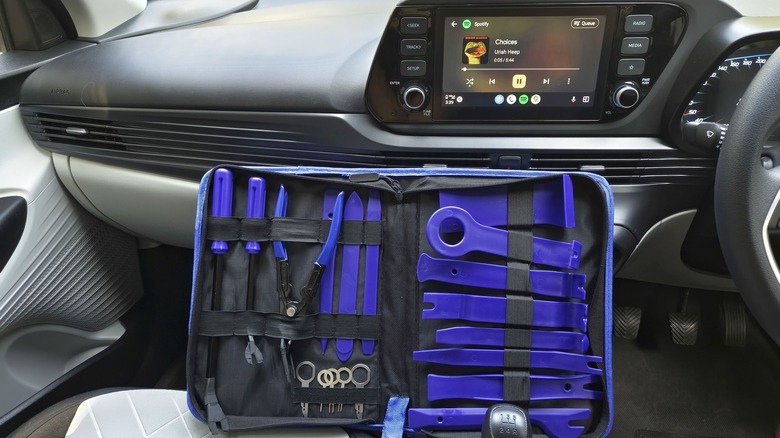3 Tools That Are A Must For Installing A New Car Stereo
A Phillips head screwdriver is (mostly) all you need to upgrade your PC, but auto upgrades are much more involved. Installing a new car stereo, for example, usually warrants disassembling almost the entirety of your car's dashboard. Installing a modern touchscreen head unit in older cars complicates things further with custom wire harnesses. This endeavor necessitates specialized tools — the likes of which you won't have lying around. Not unless you're a professional or a die-hard automotive tinkerer.
But don't take that as an excuse to make a beeline to Amazon for a random set of crimping tools. It pays to select the right tool for the task, but that depends on the complexity of the car stereo installation at hand. Worse yet, failure to use appropriate tools can also create problems ranging from annoying rattles and a marred dashboard to electrical malfunctions.
That's why we have compiled three must-have tools based on your budget and appetite for thoroughness, along with handy tips for beginners to prevent complications while installing a new car stereo.
Disassembly Tools
You can't install a new car stereo without removing the existing one. Uninstalling a head unit from the dashboard is deceptively complicated because getting to it requires the removal of hidden fasteners and stubborn dashboard trim retention tabs. While a flat-head screwdriver will technically do the job, that is guaranteed to damage the plastic trim and induce a permanent dashboard rattle. You are better off using dedicated spudgers and prybars designed for automotive trim. These tools are made from relatively soft but tough Nylon material that won't mar the dashboard finish.
Instead of buying these pry tools separately, we recommend purchasing an automotive trim removal kit. These kits come with other essentials, such as a dedicated head unit removal tool, which makes life significantly easier. The included plastic fastener extraction tool is also a godsend for removing carpets and roof liners, which is mandatory for routing audio cables effectively. The kit is more cost effective than buying a smaller selection of included tools separately.
However, not every piece of dashboard trim can be pried off with a plastic tool. Different manufacturers may use any combination of Phillips, Torx, or hex head fasteners to hold the dashboard down at strategic locations. A quality screwdriver set is, therefore, indispensable for tackling such hidden screws. It also pays to keep a good ball-end hex wrench set handy. Hex drivers with ballpoint ends can turn fasteners at an angle, which makes them essential for hex head screws hidden away in hard-to-reach places.
Wire Terminal Crimping Kit
Modern car stereo unit upgrades often involve replacing an antiquated tape or compact disc head unit with a modern touchscreen. This practically guarantees the need for a brand-new wiring harness. You might find a wiring harness adapter if you're lucky, but most of you will have to decide at this juncture — Either connect the original harness to your aftermarket head unit by crimping butt-spliced connections or create a custom wire harness from scratch.
The first option is easy to pull off. All you need is a wiring diagram and a cheap crimping tool designed for appropriately sized butt splice connectors. However, this makes the resulting wire harness unwieldy and not nearly as bulletproof as a custom-made alternative.
On the other hand, a custom wire harness is a complicated affair. For starters, you'll need to look up the service manuals for both stereo units to identify the appropriate connectors and purchase them from reputed sources, such as Digikey or Mouser Electronics. Unfortunately, the mandatory reading doesn't end there. You'll also have to refer to the technical data sheets for each connector type to figure out the pin type and size, which dictates the type of crimping tool required.
In most cases, reputed brands such as Engineer make combination crimping tools that can handle multiple connector types. If you're wondering why we haven't recommended soldering irons, that's primarily because soldered wire connections are known to fail in automotive applications.
Wire Pullers
Even the most basic car audio system involves multiple speakers peppered across the length and breadth of the vehicle's interior. The painstaking process of routing wires through roof liners, panels, and conduits will be time-consuming. A wire puller makes this task a lot quicker and frustration-free.
Also known as a wireworm, this tool is typically a flat length of plastic with hooks or eyelets at both ends. Snaking it through tight spaces is easy thanks to its inherent rigidity and slipperiness, which allows it to pull wires through conduits that are otherwise too tight and long to feed cables across the usual way.
It is tempting to save money on a wire puller by disassembling the interior panels and liners instead, but even that might not help in some cases. Most notably, routing wires through tightly packed conduits such as the one found on the tailgate is a nightmare without one. The tool also pays for itself if you must tackle challenging cable runs, such as the one for trunk-mounted subwoofers.
If you're on a tight budget, a reasonably thick solid-core copper wire will also work in a pinch. A suitably thick (approximately 6 AWG) length of bare copper wire is rigid and slick enough to be pushed through tight spaces. The lack of insulation also prevents it from snagging against the plastics, carpeting, and rubber conduits.



